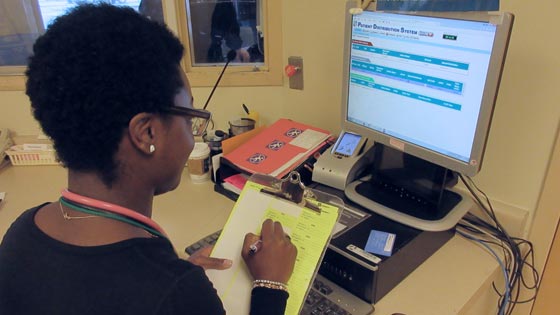
Ruth Appiah-Boateng, a Registered Nurse in the Emergency Department at Toronto General Hospital, fills in a yellow sticker used to identify which charts belong to patient who arrived by ambulance (Photo: UHN)
When ambulances arrive at the Toronto General (TGH) Emergency Department (ED), they stay there until patients are triaged and care is transferred to the hospital.
The more time that process takes, the longer the ambulance is unavailable for other calls.
Returning the vehicles to active service in the minimum amount of time is a priority for the ED team, and they are always looking for ways to further reduce the time to transfer patients from the ambulance to the hospital.
Speeding up that process puts ambulances back in service to the community faster. It also created other opportunities for improvement.
"We're much faster at moving patients from ambulances into rooms," says Ruth Appiah-Boateng, a Registered Nurse in the ED at TGH. "But when there are six ambulances all waiting to transfer patients at once, we didn't have a system for providing the ambulance identification number, the patient's name and the room number to the registration clerks."
That forced the registration clerks to go from room to room looking for patients to make sure they had the correct information necessary for admissions. Such small failures in the system have the potential to grow into much larger problems, so in the interests of prevention, the team raised the issue at a daily huddle.
Daily huddles leverage expertise
"The emergency department is an incredibly complex environment" says Debra Davies, ED Nursing Manager. "Huddling daily leverages the expertise of our team to identify and resolve small problems before they escalate."
Ruth and her colleague Stacey Quashie, also a Registered Nurse, came up with a smart way to simplify the process. Finding time for such things isn't easy in the ED, but they realized if they didn't have time to look for patients, they had to make time to find a solution.
"We designed small, bright yellow stickers where we can write the patient's name, room number and the ambulance number," says Ruth. "We just stick them on the registration charts and it saves the clerks a lot of time and walking."
The team realized the stickers had another benefit: they showed at a glance which of the patients waiting to be admitted arrived in an ambulance, making it easier to prioritize them.
Sticker system recently put to the test
The stickers were put to the test recently when the ED at St. Michael's Hospital was closed due to a burst pipe, and ambulances were diverted to TGH.
"It was incredible," says Debra. "We had eight ambulances waiting to transfer patients to us, along with everyone else in the waiting room. All their charts were mixed together in the triage rack but you could tell immediately which people were in ambulances.
"That helped us prioritize and get ambulances back to the community faster."
Mary Kay McCarthy, Director of the Emergency Department at TGH, says staff there have engaged in Lean process improvement for several years.
Despite ongoing pressures from increasing patient volumes, Debra and the Emergency Department interprofessional team continue to work together, using Lean principles to develop creative strategies that improve safety, workflow, and ultimately the patient experience.
